Did you know that the Dumb Cane, also known as Dieffenbachia, can grow up to 6 feet tall? It comes from the lush tropical rainforests of Central and South America. This popular houseplant is loved for its beautiful leaves and easy care. In this complete guide, I will share all you need to know to grow a healthy Dumb Cane at home.
Key Takeaways:
- Learn the secrets to growing a stunning Dumb Cane by understanding its appearance, light requirements, and watering needs.
- Discover the best pot and soil choices for optimal growth, as well as tips for fertilizing, pruning, and maintaining your Dumb Cane.
- Unlock the art of propagating Dumb Cane through stem cuttings and division to expand your plant collection.
- Equip yourself with knowledge on how to handle pests and diseases that may affect your Dumb Cane, ensuring its long-term health.
- Master the art of overwintering your Dumb Cane, keeping it happy and thriving during the colder months.
Why Do We Love the Dumb Cane For Apartments?
The Dumb Cane is popular for apartments. It offers many benefits for indoor living.
Air-purifying qualities: This plant cleans the air by removing toxins. It makes your home’s air healthier.
Pet-friendly nature: The Dumb Cane is safe for pets but be careful. Its sap can be harmful if pets eat it. Keep it where pets can’t reach.
Size that suits apartments: Its small size is perfect for small places. It grows to be 3-6 feet tall. This plant doesn’t need much room to grow.

| Benefits of the Dumb Cane for Apartments |
|---|
| Air-purifying qualities |
| Pet-friendly nature |
| Compact size |
How to Grow a Dumb Cane – Learn to Grow this Indoor Beauty
For a healthy Dumb Cane, choose the right pot and soil. Pick a spacious pot with drainage holes. This stops too much water from gathering. Well-draining soil helps the roots breathe and stay moist.
Light is key for the Dumb Cane’s growth. Put it where there’s lots of light but no direct sun. Too much sun hurts the leaves. It likes bright places but can also grow in less light.
How you water affects the Dumb Cane’s health. The soil should be moist but not too wet. Too much water causes root problems. Check the soil with your finger. If it’s dry, it’s time to water. For humidity, aim for 50-60%. You can spray the leaves or use a humidifier.
The plant needs food and care to stay healthy. Use a balanced fertilizer as told on the package. Pruning helps it grow thick and removes bad leaves. Check often for bugs or sickness and deal with them fast.
Propagation helps grow more Dumb Cane plants. You can use stem cuttings or split the plant. Cuttings come from healthy parts and need water or wet soil. Splitting makes smaller plants from the main one.

Watch out for problems like pests or diseases in your Dumb Cane. Look for signs like yellow leaves or slow growth. Treat issues quickly with safe sprays or treatments.
To do well with a Dumb Cane, focus on the right pot and soil, light, and water. Feed it well, prune, try making new plants, and keep an eye out for trouble. Follow these steps for a lovely indoor plant.
Appearance of Dumb Cane
The Dumb Cane, or Dieffenbachia, looks amazing. It is known for its big, pretty leaves. These leaves have cool patterns. They are a mix of green, white, and yellow. This mix makes the plant stand out. Each leaf is big and has a sharp tip. They can grow up to 18 inches long. When this plant is inside, it can grow between 3 and 6 feet tall. This makes it a big, catchy piece in any room. In addition to its striking appearance, the Dumb Cane is relatively easy to care for, making it a popular choice for both novice and experienced plant lovers. For those looking to maintain a lush indoor garden, it’s useful to know some ponytail palm care tips as well, since the ponytail palm is another beautiful houseplant often paired with Dieffenbachia. To ensure both plants thrive, it’s essential to provide the right balance of sunlight, watering, and humidity.
If you like your home to look elegant and beautiful, a Dumb Cane is a good choice. Its big leaves grab attention. They add a fresh, jungle-like vibe inside. This plant fits well in any room. It doesn’t matter if your room is simple or full of colors. The Dumb Cane’s leaves will always look stunning.
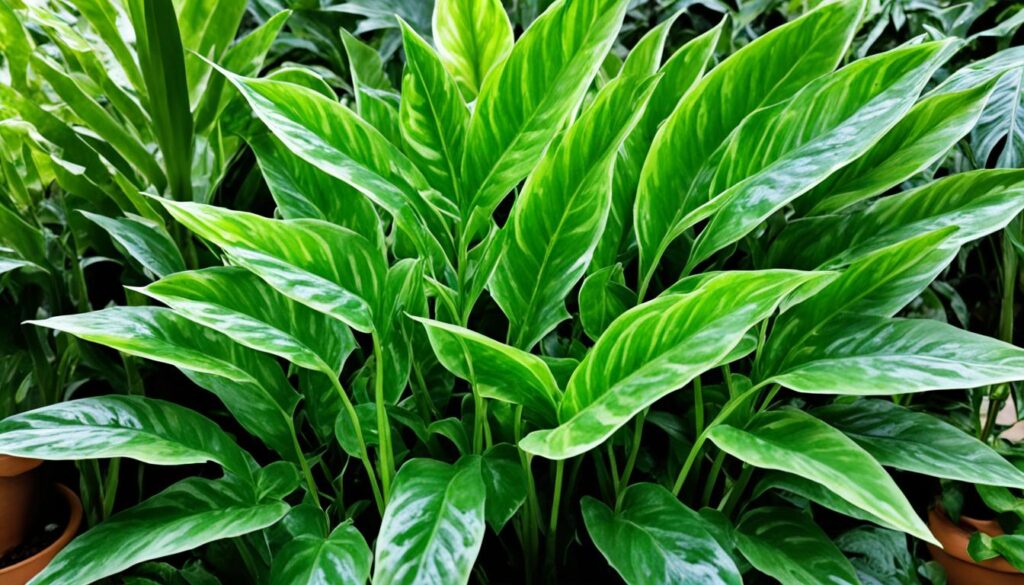
Light Requirements for Dumb Cane
Good light is very important for Dumb Cane’s health and growth. We’ll talk about what kind of light is best for your plant. This will help it grow well and look great.
“Finding the right balance of light is crucial for optimal growth and vibrant foliage.”
Dumb Cane loves light but not too much. Put it near a window but not in direct sun. Use thin curtains to protect it.
No much sun? No problem. Dumb Cane can grow in less light too. Put it in a bright room. You can use lamps to help.
But, it needs some light. If it’s too dark, the plant won’t grow well.
Here’s what to remember for Dumb Cane’s light:
- It likes bright but not direct sunlight.
- Don’t put it in too much sun. It can hurt the leaves.
- Use lamps if there isn’t enough sun.
- It should get some light to be healthy.
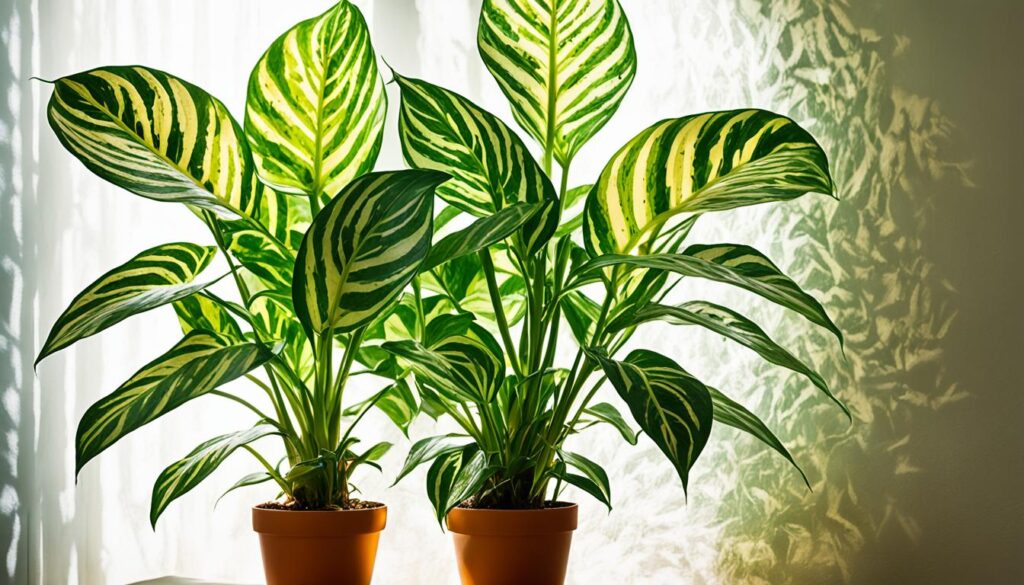
Watering Requirements of the Dumb Cane
Watering your Dumb Cane right is very important. Too much or too little water can harm the plant. You need to know how much water it needs. This will keep your plant healthy and happy.
It’s key to water your Dumb Cane just right. It likes to stay moist but not too wet or dry.
Signs of Overwatering:
- Yellow or brown leaves
- Wilting, even if soil is wet
- Root rot or a bad smell from the soil
If you see these signs, you might be giving it too much water. Water less and let the soil dry before you water again. This helps the plant.
Signs of Underwatering:
- Leaves droop or wilt
- Leaves are dry and crispy
- The soil is very dry
If you see these, your plant needs more water. Water more often. Check the soil to make sure it’s moist enough.
Here are some tips for watering your Dumb Cane:
- Use water that’s room temperature.
- Water until it drains out the bottom.
- Don’t let the plant sit in water. It can cause root rot.
- Wait for the top inch of soil to dry before watering again.
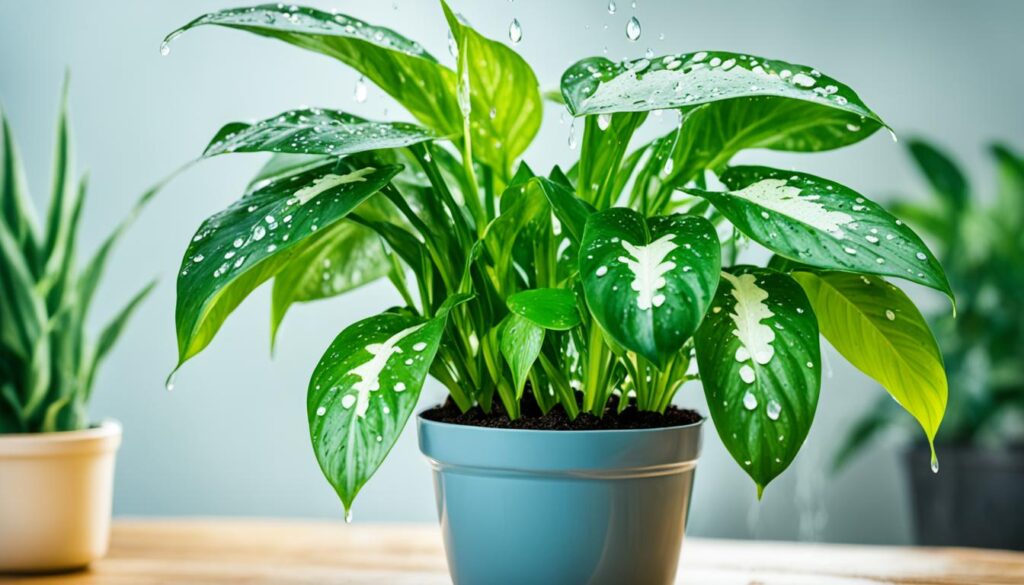
| Watering Frequency | Indications |
|---|---|
| Every 7-10 days | The top inch of soil feels dry to the touch. |
| Reduce watering | Signs of overwatering, such as yellowing leaves or root rot. |
| Increase watering | Signs of underwatering, like wilting or dry, crispy leaves. |
You might need to change how much you water. It depends on things like air humidity and pot size. Watch your Dumb Cane to see how it does. This will help you water it just right for good growth.
Fertilizing a Dumb Cane
Fertilizing is key for Dumb Cane plants to grow well. Use a balanced, water-soluble fertilizer for all needed nutrients.
Look for a fertilizer that has nitrogen, phosphorus, and potassium. This helps the plant grow well, from roots to leaves, and even flowers.
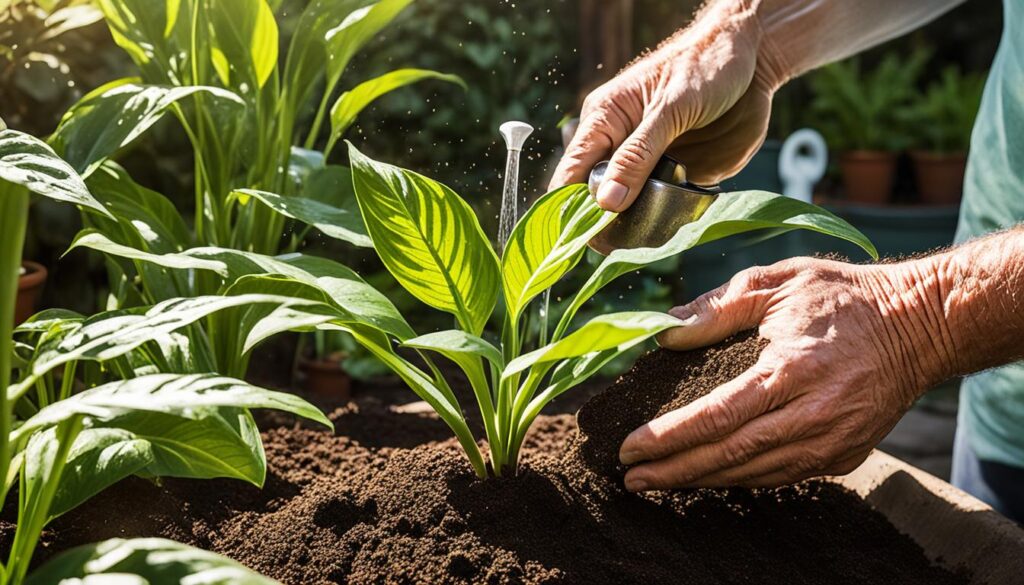
I suggest a slow-release fertilizer made for indoor plants. It gives nutrients slowly, so your plant gets fed without damage. Always follow the package for how much to use and how often.
Fertilize your Dumb Cane every 4-6 weeks in the growing season. This is usually from spring to early fall.
In late fall and winter, don’t fertilize much or at all. This is when the plant isn’t growing much.
Always mix fertilizer as the label says. Too much can hurt your plant, making leaves change color and get damaged.
Flush soil with water every few months. This stops too much fertilizer from harming the soil and plant.
Every Dumb Cane is different. Watch how yours grows and change how you fertilize if needed. This keeps it healthy and happy inside.
Potting a Dumb Cane
It’s very important to pot your Dumb Cane right. We’ll talk about picking the right pot, the best soil, and when to repot.
Choosing the Right Pot Size
Picking the right pot size is key. Choose one just a bit bigger than the roots. This gives them space to grow. Avoid big pots as they can make the soil too wet and hurt the roots.
Using the Ideal Potting Mix
The soil mix you use is very important. You want one that drains well. This helps the roots stay healthy. Mix peat moss, perlite, and organic matter for a good soil.
Repotting When Necessary
As your Dumb Cane gets bigger, it might need a new pot. Look for roots coming out of the bottom or the top soil. When repotting, be gentle with the roots and use new soil. Spring is the best time for this.
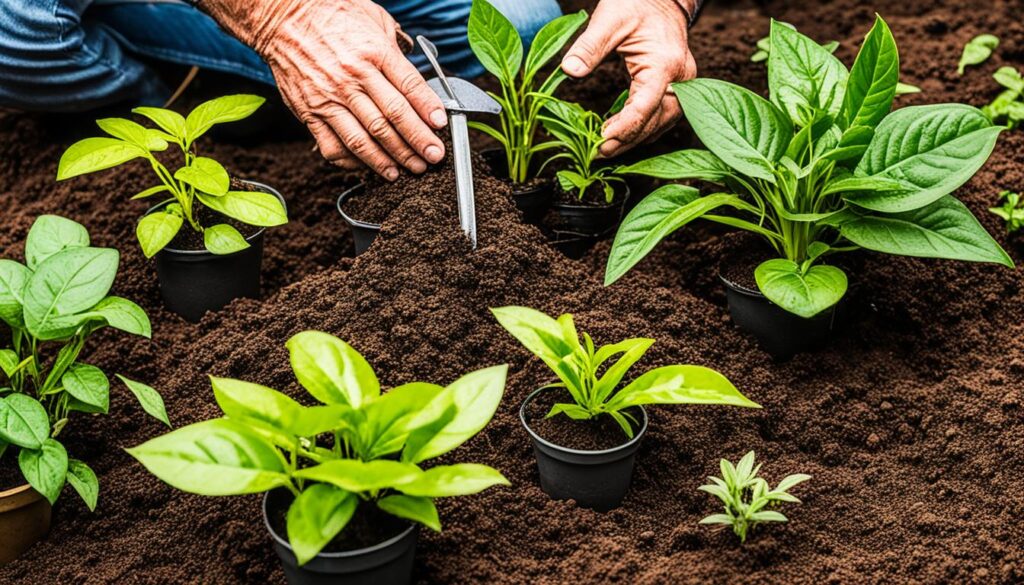
Getting the potting right helps your Dumb Cane grow well. Make sure it has room, the right soil, and repot if needed. This makes your plant happy and healthy.
Propagating a Dumb Cane
Making more Dumb Canes is a great way to grow your collection. You can also share them with friends. Try stem cuttings or division to make new plants. Both ways are easy and often work well.
Stem Cuttings
Stem cuttings mean you take part of a Dumb Cane’s stem to grow a new one. Here is a simple guide:
- Pick a healthy stem with 2 or 3 nodes (nodes are small bumps on the stem).
- Cut the stem below a node with a clean, sharp tool.
- Take off the bottom leaves, leaving some top leaves.
- You can use rooting powder on the cut end to help roots grow (this is optional).
- Get a pot with good soil and make it a little wet.
- Put the stem in the soil, covering at least one node.
- Put the pot somewhere warm and bright, but out of direct sunlight.
- Keep the soil damp but not too wet.
- Soon, you should see new roots. When the roots are big enough, move the plant to a bigger pot.
Division
Division means you split a grown Dumb Cane into parts that can grow on their own. Here’s how:
- Take the plant out of its pot carefully to avoid hurting the roots.
- Softly pull the roots apart into smaller pieces.
- Make sure each piece has a stem and enough roots.
- Fill new pots with fresh soil.
- Plant each piece in its pot, covering the roots with soil.
- Water the new plants well.
- Put them in a spot that’s warm and has light but no direct sunlight.
- Look after the plants like you would any Dumb Cane.
Follow these steps for stem cuttings and division to make new Dumb Canes. Try both ways to see which you like best.
Get your gardening stuff, start propagating, and enjoy your new Dumb Canes. You’ll fill your home with plants or give some to friends.
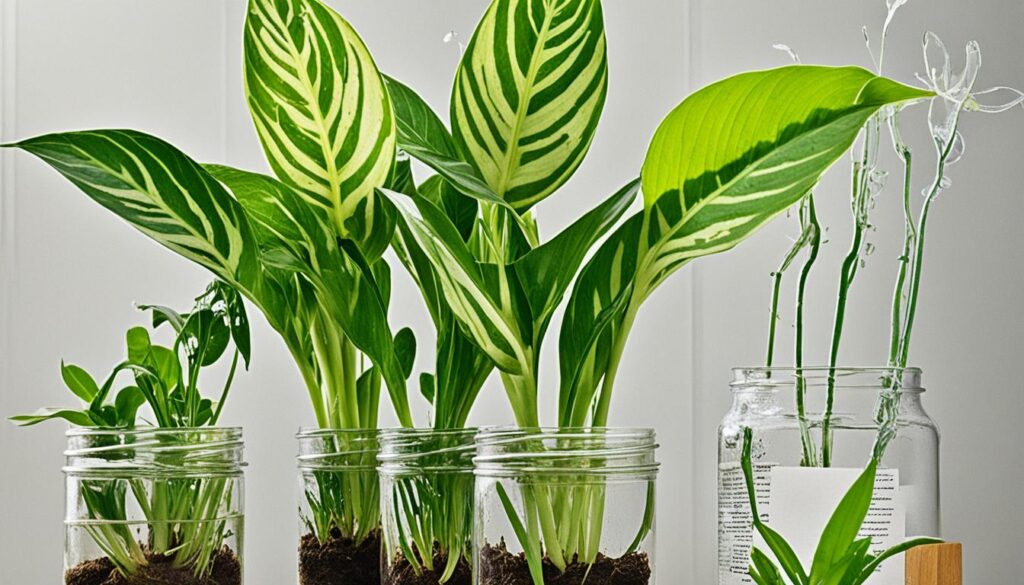
Growth and Development of the Dumb Cane
It’s important to know how the Dumb Cane grows. This helps you take good care of it. You can spot health problems early.
A Dumb Cane starts from a tiny seed or cutting. Soon, you’ll see it begin to grow.
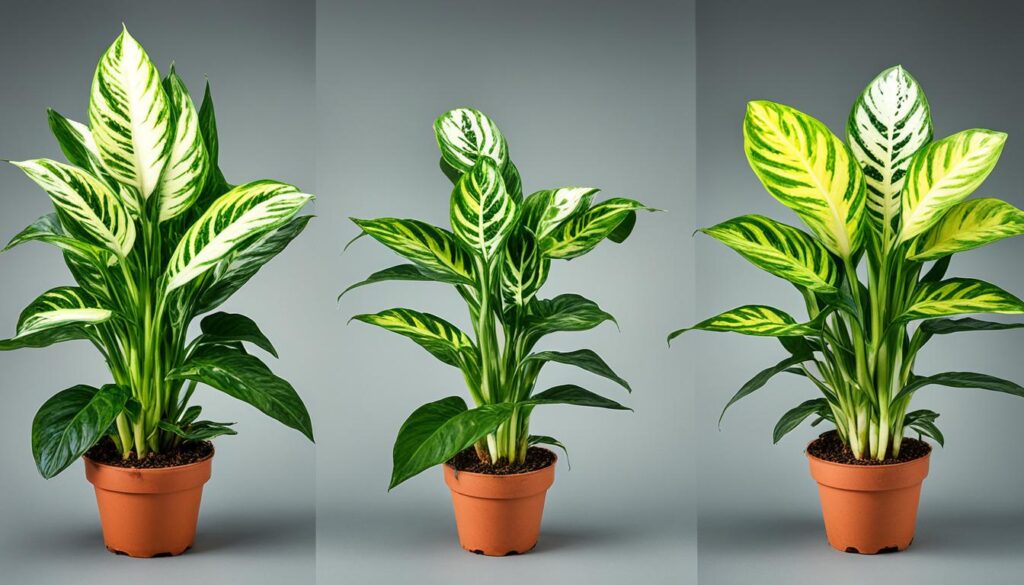
At first, it grows new leaves and stems. The leaves start small and get bigger over time.
“Watching your Dumb Cane grow from a tiny seedling to a mature plant brings a sense of joy and accomplishment.”
When it’s fully grown, the Dumb Cane gets taller. Some can be up to 6 feet high. This is when it grows big, beautiful leaves.
The Dumb Cane needs light, water, and food to grow well. Taking care of it right helps it stay healthy.
Next, we’ll talk about the Dumb Cane’s growth stages. We’ll give tips for each phase.
Dealing with Pests and Diseases in the Dumb Cane
The Dumb Cane plant can get sick or face bug issues. It’s important to know what problems it can have to keep it well.
Bugs like spider mites, mealybugs, and aphids can harm your Dumb Cane. They damage the leaves and stop its growth. Spotting these bugs early is key to stop them.
Spider mites are small pests that eat leaf sap. This makes yellow spots and webbing. Clean the leaves with a wet cloth to fight them. Use neem oil or soap to keep them away.
Mealybugs look like small, white cotton bugs. They group on leaves. You can clean them with alcohol on a cotton swab. Or, spray water and soap on them.
Aphids are soft bugs that gather on leaves and stems. They make leaves curl and create sticky honeydew. Cutting off bad areas and spraying with soap and water helps.
Diseases can also harm the Dumb Cane. Stopping them before they start is best. Here’s how:
- Make sure air flows well around the plant.
- Don’t water too much to avoid root rot and fungi.
- Check new plants for diseases before putting them near your Dumb Cane.
- Clean your gardening tools to stop germs from spreading.
If your plant gets sick, act fast to help it. What you do depends on the sickness. Sometimes, cutting off bad parts and using fungicide works. If it’s really bad, you might need to throw the plant out. This stops the sickness from spreading.
Preventing problems and quick fixes are best for a healthy Dumb Cane. Stay alert and tackle any issues right away. Then, your plant will grow well and look great.
Common Dumb Cane Pests
Dumb Cane plants can get hurt by certain bugs. It’s smart to know which ones and how to stop them.
Spider Mites
Spider mites are tiny bugs hard to see. They like warm, dry places and drink sap from plants. These bugs leave dots and webs on leaves. Leaves might look spotted or change color.
To fight spider mites:
- Make the air moist around your plant. Spider mites hate that.
- Clean leaves with a wet cloth to take mites off.
- Use bug-killing soap or oil if there are a lot of mites.
Mealybugs
Mealybugs look like tiny cotton balls. They eat plant sap, making growth slow and leaves yellow. You can find them in groups on stems and under leaves. They also make a sticky mess that ants like.
To stop mealybugs:
- Use a cotton swab with alcohol to remove them gently.
- Bring in ladybugs or other helpful bugs to lower their numbers.
- Neem oil helps to get rid of mealybugs.
Aphids
Aphids are small and soft. They quickly grow in number and harm leaves. You can find them on new parts of the plant. Aphids can be many colors.
For aphids, try these steps:
- Cut off areas that have lots of aphids. Throw those leaves away.
- Invite friendly bugs like ladybugs to eat the aphids.
- If there are many aphids, bug soap or natural insecticide works well.
Check your Dumb Cane often for bugs. Acting fast keeps your plant healthy and beautiful.
Natural Predators
Controlling pests in your Dumb Cane can be achieved by using natural predators. Also, use good plant care methods. These steps are safe and good for the earth. By bringing in helpful bugs that eat pests, your Dumb Cane stays healthy.
To get helpful bugs, make your garden or inside space diverse and inviting. Having different plants like daisies, marigolds, and fennel will bring these insects.
It’s also key to take care of your plants well. Clean the leaves often and remove dead stuff to stop pests. Check your plants for pests often. If you find some, keep the sick plants away from healthy ones.
Sometimes, you might need to use chemicals to fight a lot of pests. But, be careful with chemicals. Only use things made for Dumb Cane. Also, use them as told to keep your plant safe.
Using helpful bugs and proper care can help fight pests in your Dumb Cane. This keeps your plant healthy and strong.
Disease Prevention For Dumb Canes
Keeping your Dumb Canes healthy is important. Following some tips can help prevent diseases. This way, your plant stays strong and healthy.
- Provide proper care: Make sure your Dumb Canes get enough light, water, and food. Good care helps them fight off diseases.
- Use disease-resistant varieties: Pick Dumb Canes that are tough against diseases. These plants get sick less often.
- Maintain good hygiene: Keep your plants and their area clean. Get rid of dead plants quickly. They can attract pests and diseases.
- Monitor for early signs: Check your Dumb Canes for bad signs like yellow leaves. Catching problems early can stop diseases from spreading.
- Isolate infected plants: If a plant looks sick, keep it away from others. This helps stop diseases from spreading. Ask a plant expert what to do next.
- Avoid overwatering: Too much water can cause root problems. It can also attract diseases. Water your Dumb Canes right, letting soil dry a bit between.
Prevention is the best way to keep your Dumb Canes looking great. Use these tips for healthy, beautiful plants.
Tips for Maintaining Dumb Canes
Keeping your Dumb Canes healthy requires regular care. Here’s how to make sure they stay in top shape:
- Wiping leaves: Dust on leaves can stop them from making food properly. Use a damp cloth to clean the leaves. This helps them get air.
- Providing outdoor exposure: Sometimes, your Dumb Canes like being outside. Choose a shady spot that doesn’t get direct sun. This makes them happy with fresh air and moisture.
- Adjusting the watering schedule: How much water Dumb Canes need changes with the seasons. Water more when it’s warm and they’re growing. Water less when it’s cool and they’re resting. Always check the soil to see if it’s dry or wet before you water.
Follow these tips to keep your Dumb Canes looking great. They’ll make your indoor spaces more beautiful with their green leaves.
Tips for Successful Overwintering of Dumb Cane
In winter, Dumb Cane needs special care. These tips will help it stay healthy all year.
1. Maintain consistent temperature: Keep it between 60-75°F (15-24°C). Stay away from cold drafts and big temperature changes.
2. Provide adequate light: They need bright, indirect light in winter. Place them near a window for sunlight or use grow lights.
3. Adjust watering frequency: Water less in winter. Let the soil’s top inch dry out first. Check the soil often.
4. Increase humidity: Winter air inside can dry out leaves. Use a humidifier or mist the leaves to help them.
5. Limit fertilizer application: They grow slower in winter. Use less fertilizer. Half-strength monthly or every six weeks is enough.
6. Monitor for pests and diseases: Check your plant often for pests or diseases. Treat problems quickly with safe methods.
7. Avoid drafts and temperature extremes: Protect them from sudden temperature changes and drafts. Keep them in stable conditions for health.
Follow these tips for good winter care of your Dumb Cane. Proper care will keep it beautiful and healthy during winter.
Growing Dumb Cane from Seed
Growing Dumb Canes from seeds can be fun. You can grow your collection or start new. It lets you see the whole life of these lovely plants. I will tell you how to start seeds and take care of young plants.
Germination: Here’s how to grow Dumb Canes from seeds:
- Pick good Dumb Cane seeds from a trusted place. They should be fresh.
- Use a seed tray or small pots with a mix that drains well.
- Put the seeds on top of the soil and press lightly. They need light to grow, so don’t cover them with soil.
- Keep it warm and moist, around 75-80°F (24-27°C) and 70% humidity. A seed tray cover or plastic can help.
- Keep the soil moist but not too wet. A spray bottle works well.
- Wait 2 to 4 weeks for them to start growing. Check on them often.
Seedling Care: Care for the young plants like this:
- Put them where they get light but no direct sun. A grow light or windowsill is perfect.
- Daytime should be 70-80°F (21-27°C), cooler at night.
- Water them regularly. Let the top inch of soil dry out a little first.
- Keep the air moving to stop disease. Use a soft fan or open the cover a bit.
- When they have 2 or 3 leaves, move them to their pots. Use a good potting mix.
- They still need light and water to keep growing.
To grow Dumb Canes from seeds, follow these steps and care for them right. You’ll get to enjoy seeing your plants grow from the start.
Varieties of Dumb Cane
The Dumb Cane, or Dieffenbachia, is a great indoor plant. It has many different types. Each one is special, making it fun for people who love plants. Let’s look at some popular ones and what makes them great for indoor spaces.
The D. maculata is first. It has big green leaves with light spots. It looks vibrant and elegant in any room.
Then, there’s the D. seguine. It has yellow and green leaves. This variety makes your indoor garden bright and lively. Its leaf patterns are eye-catching.
Don’t forget the D. picta, or Painted Dumb Cane. It has green and creamy white leaves. The leaves’ delicate lines make it look like art. It makes your home beautiful.

